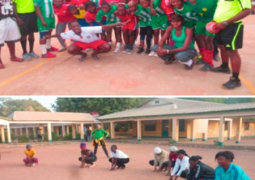The Food and Agricultural Organisation (FAO) recently trained farmers in the Lower River Region (LRR) on Disaster Risk Reduction (DRR) and adaptation on climate change, at the Jenoi Agricultural Centre.
FAO Country Representative, Dr Babagana Ahmadu told participants at the start of the two-day training that the development came under their emergency assistance project, to restore the productive capacity of vulnerable households affected by the 2012 severe weather conditions in The Gambia, following the 2011 crop failure.
“The LRR, a predominantly farming region was among the hardest hit on the low agricultural productivity for the past cropping season, due to weather hazards, which made FAO’s intervention timely as farmers prepare to go back to the land for the next season.”
According to Dr Ahmadu, the focus of all these trainings is to ensure that we build the capacity of communities and targeting vulnerable households and people who are fundamental to addressing their low resilience to the hazards, linked to development and sustainability.
He described disaster risk reduction as the central tool towards bridging the transfer from emergency interventions to resilience-building.
Farmers at the training argued that the environment at their disposal is gradually becoming less reliable for agricultural activities on counts of hazardous weather conditions.
“The temperature is commonly too high, coupled with the negative footmarks of pollution, flood, and windstorm which continue to discourage farming and threaten human habitations,” said some of the participants.
Ebrima ML Saidy, the Director of Agriculture for the Lower River Region, argued that human practices are among the leading factors that are responsible for the prevailing hazardous weather.
He pointed out that it has become a tradition for people to set fire on the forest, and thus caused loss of the forest cover.
Mr. Saidy, who said he is convinced with the possibility of addressing disaster, especially in agriculture, noted that risk reduction strategies, such as the planting of more perennial trees along the wind directions within residential areas and on farms are pertinent. He said the planting of more trees can minimise soil erosion, due to run off.
In his presentation, Lamin Saidy, the Disaster Coordinator in the region, said the Lower River Region is the most vulnerable region in terms of extreme weather hazards.
“This region is very much exposed to weather hazards in the form of wildfire, draught, windstorm and flood,” he added.
For him, the people of the region have to improve on community-based adaptation to climate changes and disaster risk reduction in order to build the resilience.


